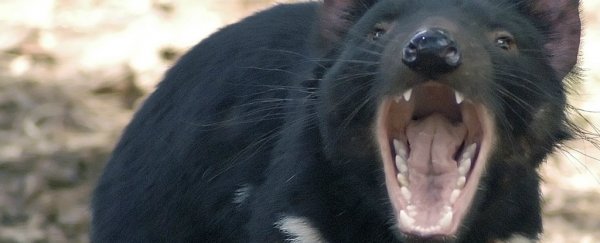A previously undiscovered flesh-eating marsupial has been identified from a fossilised tooth discovered in Queensland, Australia.
The creature, which has been named Whollydooleya tomnpatrichorum, would have been around 20-25 kilograms, much larger than its only living cousin the Tasmanian Devil, which comes in at a measly 10 kilos.
"W. tomnpatrichorum had very powerful teeth capable of killing and slicing up the largest animals of its day," says study lead author Mike Archer, from the University of New South Wales (UNSW).
"This was an animal which was very considerably bigger than the largest [hypercarnivore] we've got today, the Tasmanian devil, probably two to three times," Archer said in an interview with the ABC.
This isn't the first animal the team have discovered, having unearthed a snail eating marsupial last month, a giant platypus back in 2013, and huge koalas in 2012.
Oh, and the world's oldest, and nearly the largest, sperm in 2014. All of those animals (or animal fluids) were discovered at a site called Riversleigh, one of the richest fossil sites in the world.
What's interesting about this discovery is that it is the first fossil to be formally identified from a new site, which they've dubbed 'New Riversleigh'.
"Fortunately, in 2012, we discovered a whole new fossil field that lies beyond the internationally famous Riversleigh World Heritage Area fossil deposits in north-western Queensland," said Archer.
"This exciting new area - New Riversleigh - was detected by remote sensing using satellite data."
The team are exploring fossils in the new site, and hope to understand more about the late Miocene period - between 12 and 5 million years ago. This was when Australia changed from a country filled with rainforests, to the drier lands we know today.
"New Riversleigh is producing the remains of a bevy of strange new small to medium-sized creatures, with Whollydooleya tomnpatrichorum, the first one to be described," said Archer.
"These new discoveries are starting to fill in a large hole in our understanding about how Australia's land animals transformed from being small denizens of its ancient wet forests to huge survivors on the second most arid continent on Earth."
The new site was discovered by a technique created by a PhD student at UNSW, Ned Stephens. He developed a new way to search for great fossil areas, by studying the frequencies being bounced back to satellites from known fossil sites, such as Riversleigh.
In 2012, Stephens detected a range of frequencies that matched those of a big fossil site, but it wasn't Riversleigh or any known field.
Upon further investigation, the result was a whole new area to explore, which might unleash even weirder animals from early Australia.
The research has been published in the Memoirs of Museum Victoria.
UNSW Science is a sponsor of ScienceAlert. Find out more about their world-leading research.
